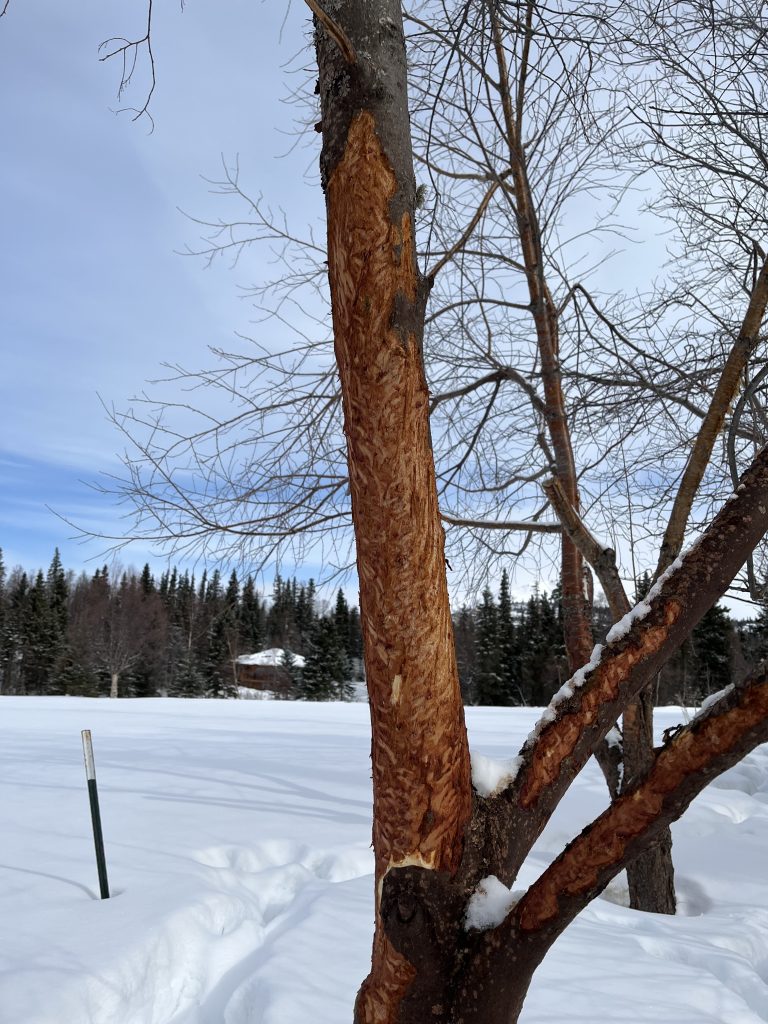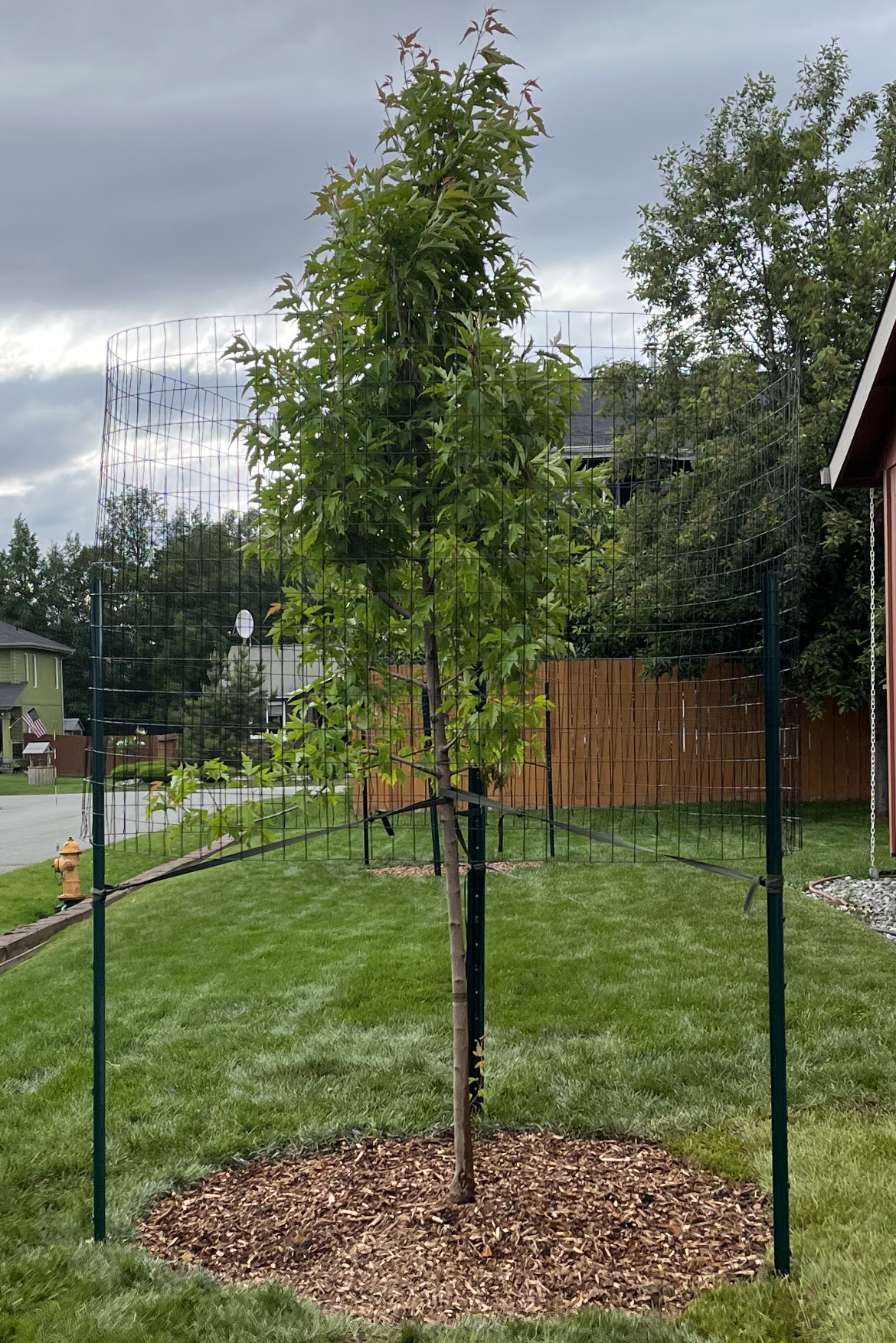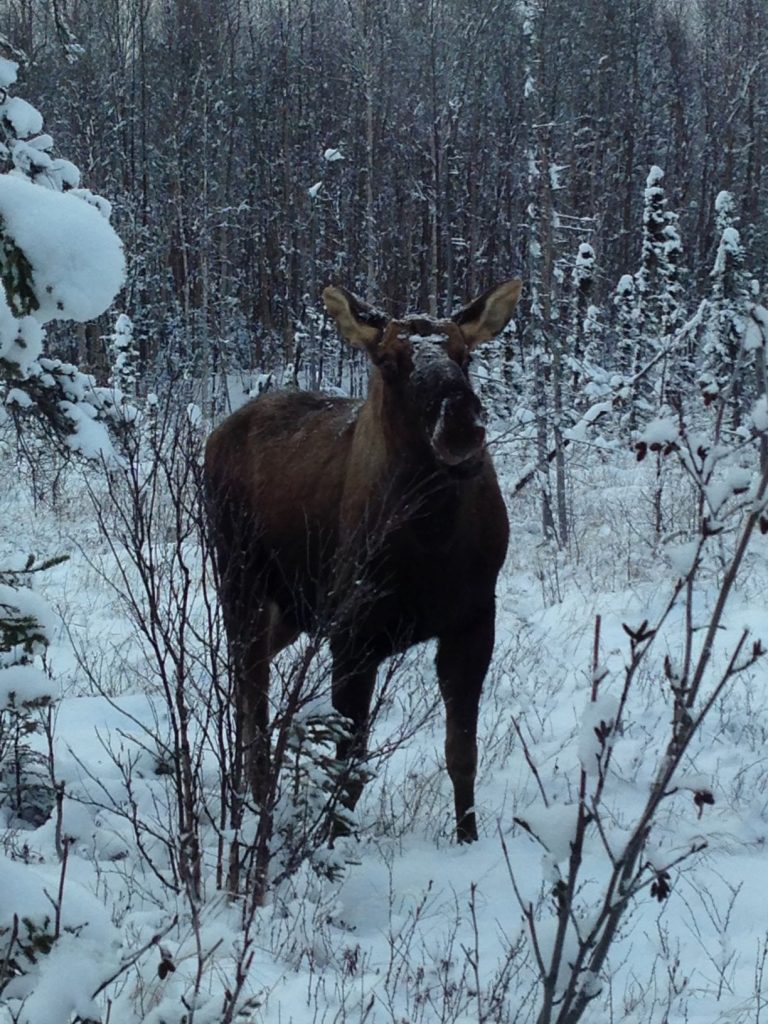It’s devastating to invest hours of your summer watering a tree or years of your life watching it grow only for it to be decimated by a moose in a short period of time.
I’ve heard many stories and seen evidence of the attempts at running them off, but oftentimes they’re just that– attempts. Preventative protection is one of many necessary steps to coexist with wildlife in your landscape. Moose, rabbits, and voles are among the most destructive to landscape trees here in Alaska. While they do damage in the summer to leafy vegetation, often the most destructive and detrimental damage is done in winter.
Alaska’s winters bring both opportunities and challenges, but navigating urban and suburban landscapes is unnatural for wildlife. It’s not made easier while they’re blanketed in multiple feet of snow. In this comprehensive guide, we’ll delve into some key biology of Alaska’s moose, explore the behaviors of rabbits and voles during winter, and provide practical tips for mitigating potential tree damage. Here at Gage, we know the frustration of having your beautiful trees munched on and mowed down by wildlife. Our goal is to foster a harmonious coexistence that respects the unique needs of wildlife while promoting the health and vitality of your Alaskan landscape.
Moose Biology in Winter
Moose undergo remarkable adaptations to survive the harsh winter. As the temperatures drop and snow blankets the landscape, moose face the challenge of finding suitable food sources. During this season, their diet shifts to include browsing on twigs, bark, and lower branches of trees. Moose exhibit several key adaptations to endure the winter months:
- Metabolic Rate Reduction: To conserve energy during winter, moose reduce their metabolic rates, allowing them to survive on limited food resources.
- Insulation Through Thick Winter Coat: Moose grow a dense winter coat that serves as insulation against the frigid temperatures. This, coupled with a layer of insulating fat, provides vital protection in Alaska’s cold climate.
- Browsing on Trees: When natural vegetation becomes scarce, moose turn to trees for sustenance. In late winter (around March) moose scrape off the bark with their upper teeth to eat the cambium – a layer in the trunk that is actively involved in growing the tree. Understanding their preferred tree species and browsing habits is crucial for creating a landscape that accommodates their dietary needs.
| Moose Interactions with Southcentral Alaska Landscape Trees and Shrubs | ||
| Favorite Foods | Less Favored | Rare and/or Avoided |
| Willow (Salix spp.) Birch (Betula spp.) Apple and Crabapple (Malus spp.) Mountain Ash (Sorbus spp.) Poplars such as Aspen and Cottonwood (Populus spp.) Rose (Rosa spp.) | **European Bird Cherry/Mayday (Prunus padus) *Chokecherries (Prunus virginiana, Prunus maackii) Lilac (Syringa spp.) Maple (Acer spp.) Cotoneaster (Cotoneaster spp.) Peashrub (Caragana spp.) | Spruce (Picea spp.) Alder (Alnus spp.) Pine (Pinus spp.) |
Moose will feed on what is available. If their options are limited, there’s a high chance that means they’re coming for your ornamental tree.
With their small size, younger trees are more susceptible to devastating damage. While risk goes down as they age, damage occurs on a case by case basis. It’s important to know which species are present in your yard, their relative risk level, and to have a plan to prevent and/or mitigate damage.
**Please note, European Bird Cherry are invasive to Alaska, and create risk to its flora and fauna. Under certain circumstances they are poisonous. For more information, please stay tuned for our post on invasive trees and shrubs.
*Chokecherries are non-native and while not categorized as invasive, are problematic to moose. Under certain circumstances they are poisonous.
Mitigating Moose Damage


Left: Moose damage to bark.
Right: Moose fencing.
If your trees have fallen victim to moose browsing, here’s what you can do:
- Implement Protective Measures: Use tree guards, wire mesh, or fencing to create a protective barrier around vulnerable trees to prevent browsing. Organic sprays are also available for deterrence. Be sure to perform regular inspections of any protective measures to ensure no damage is done to the tree as it grows.
- Assess and Prune: Evaluate the extent of the damage and carefully prune affected branches. Make clean cuts just outside the branch collar to promote proper healing.
- Do Not Apply Wound Dressing: While previously recommended, research shows wound dressing does not help trees and may even do them harm. Trees create their own barriers to prevent decay, so adding something on top is pointless.
- Water: Provide the tree with water to support recovery. Healthy trees are better equipped to withstand environmental challenges. If the damage is severe, you may consider the application of a fertilizer, but only after consulting an arborist. The addition of fertilizer to stressed trees is a very finicky process, and is done on a case by case basis.
- Promote and Provide Alternative Food Sources: Consider designating feeding areas with suitable vegetation to divert moose from valuable landscape trees.
- Consult an Arborist: When in doubt, give us a call! Our arborists are happy to help.
Dealing with Rabbits and Voles
Snowshoe hares, rabbits, and voles also play a role in Alaska’s winter landscape, posing challenges for tree enthusiasts. In small shrubs especially, rabbits and voles will chew off all bark around the trunk of a tree, effectively gridling it and causing death. Here’s some tips to keep that from happening:
- Tree Guards and Repellents: Install tree guards made of hardware cloth or plastic to create a physical barrier around the trunk. Apply repellents to discourage rabbits and voles from gnawing on the bark.
- Mulch Management: Keep mulch away from tree bases to reduce vole habitat.
- Diverse Landscape Planning: Create a diverse landscape with a mix of less palatable tree species to reduce the attractiveness of your property to wildlife and minimize the potential for damage.
Promoting Coexistence
Coexisting with Alaska’s wildlife involves understanding and respecting their natural behaviors. By incorporating protective measures that prioritize the health of your trees and the well-being of wildlife, you can create a landscape that harmoniously accommodates these creatures.
- Implement Protective Measures Responsibly: When using tree guards and fencing, ensure they are installed in a way that does not harm the moose or other wildlife. Balancing protection with the principles of responsible coexistence is essential.
- Respect Natural Behaviors: Recognize that wildlife, including moose, plays a vital role in Alaska’s ecosystem. Design your landscape with an awareness of their needs, promoting a balance that benefits both flora and fauna.
- Educate and Raise Awareness: Share information about responsible coexistence with neighbors and community members. Education is a powerful tool in fostering a collective understanding of the importance of wildlife-friendly landscaping.
- Support Local Conservation Efforts: Contribute to local conservation initiatives that aim to protect and preserve Alaska’s wildlife and natural habitats. By actively participating in conservation efforts, you play a role in maintaining the delicate balance of the ecosystem.
Conclusion
Navigating Alaska’s winter wilderness requires a thoughtful approach that considers both the needs of its unique wildlife and the desire for a thriving landscape. By understanding moose biology in winter, implementing protective measures, and promoting responsible coexistence with rabbits and voles, you can create a harmonious environment that celebrates the beauty of Alaska’s natural wonders. Through education, awareness, and thoughtful landscaping, you contribute to the delicate balance that sustains both the magnificent wildlife and the vibrant landscapes of the Last Frontier.
Additional Resources:
- Landscaping for Wildlife, Alaska Department of Fish and Game
- “Willows and Moose” by Sanaa Siddiqi, Alaska Department of Fish and Game
